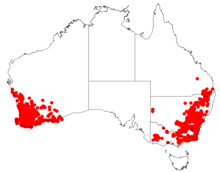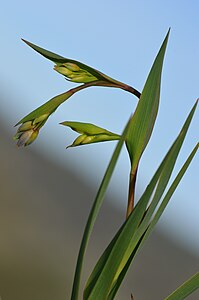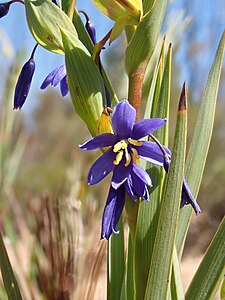| Stypandra glauca | |
|---|---|

| |
| Scientific classification | |
| Kingdom: | Plantae |
| Clade: | Tracheophytes |
| Clade: | Angiosperms |
| Clade: | Monocots |
| Order: | Asparagales |
| Family: | Asphodelaceae |
| Subfamily: | Hemerocallidoideae |
| Genus: | Stypandra |
| Species: | S. glauca |
| Binomial name | |
| Stypandra glauca R.Br. | |

| |
| Occurrence data from AVH | |
| Synonyms | |
|
Stypandra imbricata R.Br.
| |
Stypandra glauca, commonly known as the nodding blue lily, is a flowering plant in the family Asphodelaceae. It is a rhizomatous perennial plant with blue lily-like flowers with yellow stamens. It is widespread across southern areas of Australia.
Description
Stypandra glauca is a perennial herb with flowering branches to 30 cm (12 in) high and up to 1 m (3 ft 3 in) wide at the base, becoming shrub-like and about 1.5 m (4 ft 11 in) high when not flowering. The leaves are stiff, pale green to bluish, narrowly lance-shaped, stem-clasping in an alternate, opposite arrangement, and are up to 200 millimetres long. The drooping, blue flowers are borne in clusters at the end of stems, about 14 mm (0.55 in) long, about 20–30 mm (0.79–1.18 in) across, each petal about 15 mm (0.59 in) long, prominent yellow anthers, pedicel thread-like and curved. Flowering occurs from July to November and the fruit is oblong to oval-shaped capsule, 8–12 mm (0.31–0.47 in) long.
Taxonomy and naming
Stypandra glauca was first formally described in 1810 by Robert Brown and the description was published in Prodromus florae Novae Hollandiae. The specific epithet (glauca) means "sea green" in reference to the foliage.
Distribution and habitat
Nodding blue lily is a widespread species growing on a variety of soils including sand, granite, shale, limestone and clay sometimes in woodland or mostly in dry forest.
Ingestion of flowering plants has been found to cause blindness in goats.
Gallery
See also
References
- "Stypandra glauca". Australian Plant Census. Retrieved 22 January 2023.
- "FloraBase Name Currency Search: Stypandra glauca R.Br". Archived from the original on 2012-10-08. Retrieved 2010-01-24.
- Wilson, B.L. "Stypandra glauca". PlantNET-NSW flora online. Royal Botanic Garden Sydney. Retrieved 22 January 2023.
- Fairley, Alan; Moore, Philip (2010). Native Plants of the Sydney Region. Jacana Books. p. 540. ISBN 978-1-74175-571-8.
- ^ Cosgrove, Meredith (2014). Photographic Guide to Native Plants of the Australian Capital Territory. Meadow Argus. p. 220. ISBN 9780994183408.
- "Stypandra glauca". Australian Plant Name Index. Retrieved 26 January 2023.
- Brown, Robert (1810). Prodromus florae Novae Hollandiae et insulae Van-Diemen, exhibens characteres plantarum quas annis 1802-1805. London. p. 279.
- ^ Hurry, Charlotte. "Stypandra glauca". Growing Native Plants. Australian National Botanic Gardens. Retrieved 26 January 2023.
- Whittington R.J.; Searson J.E.; Whittaker S.J.; Glastonbury J.R. (1988). "Blindness in goats following ingestion of Stypandra glauca". Australian Veterinary Journal. 65 (6): 176–81. doi:10.1111/j.1751-0813.1988.tb14295.x. PMID 3415616.
External links
- The Australasian Virtual Herbarium (AVH) – Occurrence data for Stypandra glauca
- Centre for Plant Biodiversity Research, Australian Government, Canberra. "Stypandra glauca R.Br". Australian Plant Name Index (APNI), IBIS database. Retrieved 2007-10-05.
{{cite web}}: CS1 maint: multiple names: authors list (link) - "Stypandra glauca R.Br". FloraBase. Western Australian Government Department of Biodiversity, Conservation and Attractions.
- Royal Botanic Gardens & Domain Trust. "Stypandra". PlantNET - New South Wales Flora Online. Retrieved 2007-10-05.
- "Stypandra glauca". Association of Societies for Growing Australian Plants (ASGAP). 19 November 2007.


